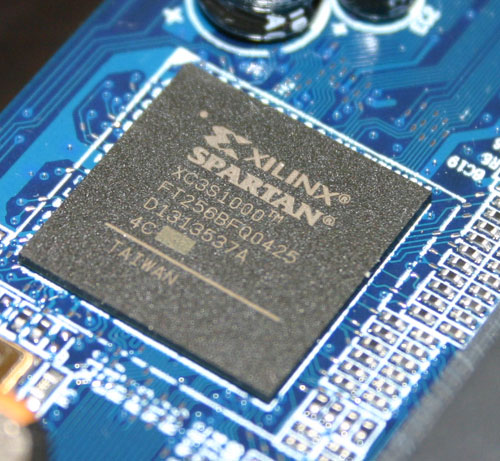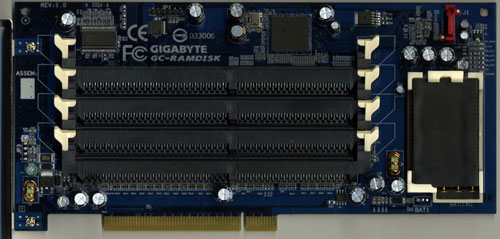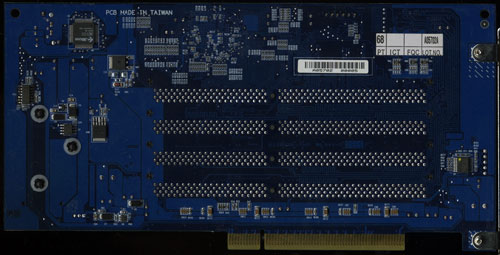Gigabyte's i-RAM: Affordable Solid State Storage
by Anand Lal Shimpi on July 25, 2005 3:50 PM EST- Posted in
- Storage
We All Scream for i-RAM
Gigabyte sent us the first production version of their i-RAM card, marked as revision 1.0 on the PCB.There were some obvious changes between the i-RAM that we received and what we saw at Computex.
First, the battery pack is now mounted in a rigid holder on the PCB. The contacts are on the battery itself, so there's no external wire to deliver power to the card.


The Xilinx FPGA has three primary functions: it acts as a 64-bit DDR memory controller, a SATA controller and a bridge chip between the memory and SATA controllers. The chip takes requests over the SATA bus, translates them and then sends them off to its DDR controller to write/read the data to/from memory.
Gigabyte has told us that the initial production run of the i-RAM will only be a quantity of 1000 cards, available in the month of August, at a street price of around $150. We would expect that price to drop over time, and it's definitely a lot higher than what we were told at Computex ($50).
The i-RAM is outfitted with 4 184-pin DIMM slots that will accept any DDR DIMM. The memory controller in the Xilinx FPGA operates at 100MHz (DDR200) and can actually support up to 8GB of memory. However, Gigabyte says that the i-RAM card itself only supports 4GB of DDR SDRAM. We didn't have any 2GB unbuffered DIMMs to try in the card to test its true limit, but Gigabyte tells us that it is 4GB.
The Xilinx FPGA also won't support ECC memory, although we have mentioned to Gigabyte that a number of users have expressed interest in having ECC support in order to ensure greater data reliability.
Although the i-RAM plugs into a conventional 3.3V 32-bit PCI slot, it doesn't use the PCI connector for anything other than power. All data is transfered via the Xilinx chip and over the SATA connector directly to your motherboard's SATA controller, just like any regular SATA hard drive.

With SATA as the only data interface, Gigabyte made the i-RAM infinitely more useful than software based RAM drives because to the OS and the rest of your system, the i-RAM appears to be no different than a regular hard drive. You can install an OS, applications or games on it, you can boot from it and you can interact with it just like you would any other hard drive. The difference is that it is going to be a lot faster and also a lot smaller than a conventional hard drive.
The size limitations are pretty obvious, but the performance benefits really come from the nature of DRAM as a storage medium vs. magnetic hard disks. We have long known that modern day hard disks can attain fairly high sequential transfer rates of upwards of 60MB/s. However, as soon as the data stops being sequential and is more random in nature, performance can drop to as little as 1MB/s. The reason for the significant drop in performance is the simple fact that repositioning the read/write heads on a hard disk takes time as does searching for the correct location on a platter to position them. The mechanical elements of hard disks are what make them slow, and it is exactly those limitations that are removed with the i-RAM. Access time goes from milliseconds (1 x 10-3) down to nanoseconds (1 x 10-9), and transfer rate doesn't vary, so it should be more consistent.
Since it acts as a regular hard drive, theoretically, you can also arrange a couple of the i-RAM cards together in RAID if you have a SATA RAID controller. The biggest benefit to a pair of i-RAM cards in RAID 0 isn't necessarily performance, but now you can get 2x the capacity of a single card. We are working on getting another i-RAM card in house to perform some RAID 0 tests. However, Gigabyte has informed us that presently, there are stability issues with running two i-RAM cards in RAID 0, so we wouldn't recommend pursuing that avenue until we know for sure that all bugs are worked out.












133 Comments
View All Comments
mattsaccount - Monday, July 25, 2005 - link
This thing would still be useful as a pagefile in some circumstances--if all your memory slots were full and/or you had extra memory lying around. This is what I had been planning to do with it (currently have 4x512mb, plus a couple other smaller capacity DDR sticks which would be nice to use b/c for photoshop stuff). But the price is too high. I'll wait till it drops.Son of a N00b - Monday, July 25, 2005 - link
I would love to get two of them and run them in RAID-5 possibly...that way you also have a back up...Gatak - Monday, July 25, 2005 - link
You'd need minimum 3 cards/disks for RAID-5.However, using this card as a journaling device for a normal filesystem, like ReiserFS or Reiser4 might be very beneficial. Wouldn't require much RAM either.
ukDave - Monday, July 25, 2005 - link
Extra things that could have been covered were:Would there be a difference with other SATA cards, such as 3Ware etc - i.e. would CPU usage make a difference perhaps?
Why not use SATA-IO (SATA-2) instead of the older and slower SATA (re: Gigabyte)?
But otherwise a very informative article, thanks Anand.
ss284 - Monday, July 25, 2005 - link
It would be best to wait for the second version of the card, which will hopefully have a cheaper IC as well as sata II support. Theres no doubt that the ram can do 3.0gb/s.Imagine what 2 of these in raid 0 would be like.
-Steve
SDA - Monday, July 25, 2005 - link
- File copy performance is mostly a moot point, because copying files from disk to disk will go as fast as the slower of the two can, and other applications that typically require disk performance (unarchiving et al) will only see a minimal performance increase due to bottlenecks in other parts of the system (which becomes even less valuable when you consider that you won't be doing a whole lot of unarchiving to a disk that small).- Gaming benefit would be okay if it you could fit more than about one modern game on it.
- Using it as a pagefile is, as Anand noted, pointless.
- It does improve boot times, but it's not a huge difference, how many of us shut down often enough to actually be bothered by a few seconds in boot?
- It does improve app loading times slightly, but if you're opening and closing apps that take a lot to open and close, it's probably because you don't have enough system memory, so buy more memory instead.
So basically: whoopee.
DerekWilson - Wednesday, July 27, 2005 - link
I'm just gonna pick at a single point ... you could install one game to the i-ram at a time and then archive them on another drive.You get fast zip times on i-ram and a single file transfer to a magnetic disk is faster than multiple small files (moving the the archive won't take long). Just unzip the game you want to play to i-ram ...
but then ... that kinda defeats the purpose doesn't it ...
I could see this being fun to play with, but I have to agree with Anand -- it needs higher capacity before it is really useful.
Plus, I'd like to see SATA-II :-)
miketheidiot - Monday, July 25, 2005 - link
I don't really see anyone using this, its costs way too much for too little storage and too little performance benefit, not to mention the risk of data loss. I'll give it a look again when they get some higher bandwidth flash or something like that. this i can pass on for now.Sea Shadow - Monday, July 25, 2005 - link
I dunno, I could see the extreme enthusiasts getting these. I mean after all, if they have the money to buy a system with SLI 7800 GTX and FX 57 this would be pocket change.BoberFett - Monday, July 25, 2005 - link
I'd imagine that in some areas the CPU is still the bottleneck and for others the 150MB/sec limit of SATA may be.